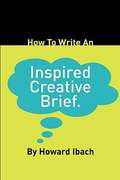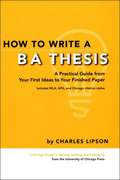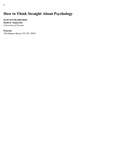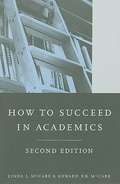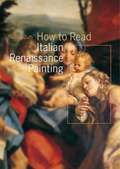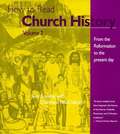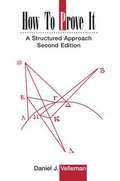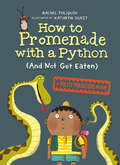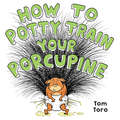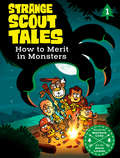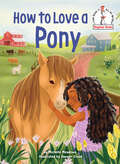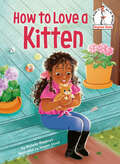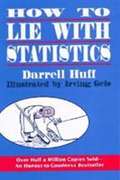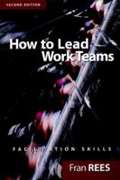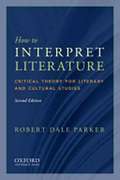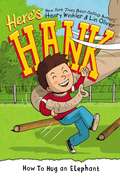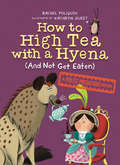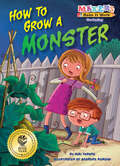- Table View
- List View
How to Write an Inspired Creative Brief
by Howard IbachThis book is very much useful for educators and students who are interested in marketing, advertising or public relations and also for those engaged in selling, marketing a product or service.
How to Write a BA Thesis: A Practical Guide from Your First Ideas to Your Finished Paper
by Charles LipsonThe senior thesis is the capstone of a college education, but writing one can be a daunting prospect. Students need to choose their own topic and select the right adviser. Then they need to work steadily for several months as they research, write, and manage a major independent project. Now there's a mentor to help. How to Write a BA Thesis is a practical, friendly guide written by Charles Lipson, an experienced professor who has guided hundreds of students through the thesis-writing process. This book offers step-by-step advice on how to turn a vague idea into a clearly defined proposal, then a draft paper, and, ultimately, a polished thesis. Lipson also tackles issues beyond the classroom-from good work habits to coping with personal problems that interfere with research and writing. Filled with examples and easy-to-use highlighted tips, the book also includes handy time schedules that show when to begin various tasks and how much time to spend on each. Convenient checklists remind students which steps need special attention, and a detailed appendix, filled with examples, shows how to use the three main citation systems in the humanities and social sciences: MLA, APA, and Chicago. How to Write a BA Thesis will help students work more comfortably and effectively-on their own and with their advisers. Its clear guidelines and sensible advice make it the perfect text for thesis workshops. Students and their advisers will refer again and again to this invaluable resource. From choosing a topic to preparing the final paper, How to Write a BA Thesis helps students turn a daunting prospect into a remarkable achievement.
How to Use Microsoft® Excel® version 1.1
by Joseph M. ManzoHow to Use Microsoft® Office Excel® The Careers in Practice Series V. 1.1 is an textbook appropriate for a course covering Microsoft Excel at a beginner to intermediate level. It is geared toward and will be accommodating for students and instructors with little to no experience in using Microsoft Excel. However, the approach is not at the expense of relevance. How to Use Microsoft® Excel® The Careers in Practice Series approaches Excel from the perspective of making personal and professional quantitative decisions. Personal decisions include big purchases such as homes and automobiles, savings for retirement, and personal budgets. Professional decisions include budgets for managing expenses, merchandise items to markdown or discontinue, and inventory management.
How to Use Microsoft® Excel®
by Joseph M. ManzoHow to Use Microsoft® Excel® The Careers in Practice Series is an textbook appropriate for a course covering Microsoft Excel at a beginner to intermediate level. It is geared toward and will be accommodating for students and instructors with little to no experience in using Microsoft Excel. However, the approach is not at the expense of relevance. How to Use Microsoft® Excel® The Careers in Practice Series approaches Excel from the perspective of making personal and professional quantitative decisions. Personal decisions include big purchases such as homes and automobiles, savings for retirement, and personal budgets. Professional decisions include budgets for managing expenses, merchandise items to markdown or discontinue, and inventory management.
How to Think Straight About Psychology
by Keith StanovichWidely used and highly acclaimed, How to Think Straight About Psychology introduces students to the critical thinking skills they need to independently evaluate psychological information. Students will learn to analyze psychological claims found in the media, distinguish between pseudoscience and true psychological research, and apply psychological knowledge to the world around them. <p><p>The 11th edition covers an extensive range of new topics and examples illustrating psychological principles, pseudoscience, and issues obscuring the real and growing knowledge base in the field of psychology.
How to Succeed in Academics
by Linda L. Mccabe Edward R. B. MccabeLinda L. McCabe and Edward R. B. McCabe, both professors at the University of California, Los Angeles, write clearly and accessibly, illustrating their main points with sample case scenarios.
How to Speak Cat: Science 4. 2 (Panorama)
by Aline Alexander Newman Gary WeitzmanNIMAC-sourced textbook
How To Read Italian Renaissance Painting
by Stefano ZuffiFilled with great masterpieces by such artists as Botticelli, Leonardo, Raphael, Michelangelo, Masaccio, Piero della Francesca, Mantegna, and Titian, How to Read Italian Renaissance Painting takes the reader into their world. As in the internationally successful and innovative How to Read a Painting, each spread uses an important painting as a way to explain a key concept, with numerous large details. Here, 180 works illuminate key ideas in Renaissance painting, from "perpective" and "the golden section" to "grace" and "symbolism." In addition, there are brief biographies of the major artists. The result is an original, accessible, and affordable volume that offers an introduction into the art and culture of the Italian Renaissance.
How to Read Church History Volume 2: From the Reformation to the present day
by Jean Comby Diarmaid MccullochSpecifically geared to the adult learner; adaptable to individual, parish, and other group needs; and richly illustrated with photos and charts, this two volume set helps teachers and students connect the content of each text with their own life experiences and the community in which they live.
How to Prove It: A Structured Approach (Second Edition)
by Daniel J. VellemanThis book helps students to develop deductive reasoning ability in general and to learn the underlying principles involved in the construction of proofs by focusing on "structured proving."
How to Promenade with a Python: A Polite Predators Book (Polite Predators #1)
by Rachel PoliquinIn this hilarious non-fiction chapter book series, a savvy cockroach shares wise tips and tricks to surviving an encounter with a charming predator who may (or may not) want to be your friend.Celeste is a cockroach, and everyone knows that cockroaches are survivors, so who better to give advice on surviving an encounter with a polite predator? Everyone also knows that taking a moonlit promenade with a deadly reticulated python (named Frank) is a very bad idea. But Celeste loves very bad ideas, and she is willing to put your life on the line to prove herself right! Need to stop a python from swallowing you head-first? Wear a lamp shade as a hat! Want to speed up a three-hundred-pound snake? Try roller skates! What's the perfect light snack for a python? A chicken! Using her superior pythonine knowledge, Celeste comes up with various strategies and solutions -- many dangerous, most absurd, but all based on the biology of pythons. Meanwhile, Frank is hatching his own plans.Rachel Poliquin has created a delightfully preposterous premise that, combined with Kathryn Durst's hilarious illustrations, will have readers laughing out loud as they learn about python biology and hunting behavior.
How to Potty Train Your Porcupine
by Tom ToroThis laugh-out-loud picture book is a hilarious take on potty training by a talented New Yorker cartoonist -- perfect for fans of If You Give a Mouse a Cookie and How to Babysit a Grandma. Two children bring home a pet porcupine, but they can only keep her if she's house-trained! After a whirlwind of increasingly zany approaches, the kids learn that sometimes the best way to solve a problem is to ask nicely. With Tom's wit and dynamic artwork, this delightful story about learning to pee will bring joy and heart to young readers.
How to Plan a Murder Mystery Party (Fountas & Pinnell Classroom, Guided Reading Grade 6)
by David Neilsen TambeNIMAC-sourced textbook
How to Merit in Monsters: Strange Scout Tales #1 (Strange Scout Tales #1)
by Matthew Cody Steve LambeA new chapter book series teeming with monsters, the biomes they roam, and the hopeless scout troop out to save them.When a scout troop learns that their sleepaway camp is really a training ground for protecting the earth’s most endangered species—monsters—the lowest-ranked Troop D (or Troop Dweeb, as the other troops refer to them) is next in line to earn their Monster Merit Badges. In How to Merit in Monsters, join Troop D on a mission to rescue the legendary Big Foot, whose water supply has been contaminated. With the help of their troop master and the ever-handy century-old Scout’s Handbook, they might just have a chance!
How to Love a Pony (Beginner Books(R))
by Michelle MeadowsA rhymed Beginner Book about a young girl and her pony, perfect for animal-lovers and budding equestrians!Meet Lily, a seven-year-old girl who lives with her parents, grandparents, and two brothers on their horse farm in the country. Lily has a Welsh pony that she adores, and in this charming Beginner Book, we see how Lily and her family work together to care for the pony throughout the changing seasons of the year. With vibrant illustrations, this is the kind of story that young riders—or kids who dream of riding—will want to read over and over!Originally created by Dr. Seuss himself, Beginner Books are fun and easy to read. These unjacketed hardcover early readers encourage children to read all on their own, using simple words and illustrations. Smaller than the classic large format Seuss picture books like The Lorax and Oh, The Places You&’ll Go!, these portable packages are perfect for practicing readers ages 3-7, and lucky parents, too!
How to Love a Kitten (Beginner Books(R))
by Michelle MeadowsIn this charming rhymed Beginner Book follow-up to How to Love a Pony—a girl finds a lost cat and her kittens on her family farm, and learns to care for them while looking for their owner. A perfect choice for animal-lovers learing to read!On a sunny day at her family's horse farm, seven-year-old Lily makes an enchanting discovery under the farmhouse porch: a mother cat and her adorable kittens! With her family by her side and some guidance from a caring veterinarian, Lily takes on the heartwarming mission of caring for the little feline family. As she searches for their rightful owner, she not only finds a new friend but learns invaluable lessons about love, responsibility, and the pure joy of unexpected friendships. Dive into this beautifully illustrated tale, and you might just find yourself reading it again and again!Beginner Books are fun, funny, and easy to read! Launched by Dr. Seuss in 1957 with the publication of The Cat in the Hat, this beloved early reader series motivates children to read on their own by using simple words with illustrations that give clues to their meaning. Featuring a combination of kid appeal, supportive vocabulary, and bright, cheerful art, Beginner Books will encourage a love of reading in children ages 3–7.
How to Lie with Statistics
by Darrell Huff Irving GeisA 1954 classic that continues to dispel false beliefs and inform the statistically naive. Huff's direct and witty style exposes how advertisers, government and the media mislead their audiences through the misuse of statistics. Huff then explains how the reader can see through the smoke and mirrors to get to the real meaning-- if any-- of what is presented. Annotation c. by Book News, Inc., Portland, Or.
How to Lead Work Teams
by Fran ReesWhile the first edition of this guide, published in 1991, focused on making the transition from "manager" to "team leader," this latest edition explores the idea of leading teamwork in dynamic, change- driven organizations. The need for facilitative leaders is greater now because managers are working in faster-paced arenas, in more volatile markets, with fewer precedents and greater consequences. The guide is intended for team leaders, project managers, HR professionals, organization consultants, trainers, and anyone who must take a leadership role to get their job done. Rees is a Phoenix-based consultant who specializes in team development, team leadership, and facilitation training. Annotation c. Book News, Inc., Portland, OR (booknews.com)
How to Interpret Literature: Critical Theory for Literary and Cultural Studies
by Robert Dale ParkerOffering a refreshing combination of accessibility and intellectual rigor, How to Interpret Literature: Critical Theory for Literary and Cultural Studies, Second Edition, presents an up-to-date, concise, and wide-ranging historicist survey of contemporary thinking in critical theory. <p><p> The only book of its kind that thoroughly merges literary studies with cultural studies, this text provides a critical look at the major movements in literary studies since the 1930s, including those often omitted from other texts. It is also the only up-to-date survey of literary theory that devotes extensive treatment to Queer Theory and Postcolonial and Race Studies. How to Interpret Literature, Second Edition, is ideal as either a stand-alone text or in conjunction with an anthology of primary readings such as Robert Dale Parker's Critical Theory: A Reader for Literary and Cultural Studies.
How to Hug an Elephant (Here's Hank #6)
by Henry Winkler Scott Garrett Lin OliverWhen Hank's class takes a field trip to the zoo, he quickly gets lost after his partner (and nemesis) ditches him. Unable to read the map, Hank wanders and finds himself locked in a habitat with Elsie, an elephant recently rescued and kept isolated. He begins a game of soccer with her, and they become fast friends. But when Hank notices how lonely Elsie is, he's determined to help her find her own animal friends.
How to High Tea with a Hyena: A Polite Predators Book (Polite Predators #2)
by Rachel PoliquinThe second book in a hilarious illustrated non-fiction chapter book series starring a savvy and stylish cockroach who guides the reader through an encounter with a charming -- and dangerous -- predator. Is this hyena drooling for tea and crumpets . . . or for you?!Celeste is a cockroach, and everyone knows that cockroaches are survivors, so who better to give advice on surviving an encounter with a polite predator? High teas are dainty meals with pretty teacups: you nibble tiny cakes, sip milky tea and chit-chat about not-so-important things like why doughnuts have holes and if fish have eyebrows. But Ruby the hyena is loud, ferocious and tends to slober. High-speed gobbling makes good sense in the wild, but it is a definite no-no in the tearoom! And Ruby just happens to be Queen of a very large clan of hungry hyenas. Will high tea be ruined by uninvited guests? Is Ruby peckish for something other than Celeste's famous cream buns? Using her vast knowledge of hyenas, Celeste comes up with lots of strategies to get through high tea in one piece. Many of her suggestions are dangerous, most are absurd, but all are based on true hyena biology and hunting behavior.
How to Grow Tomatoes
by Kristin Cashore Nicole WongThe fun and excitement of English and Language Arts learning continues in Grade 2 of Reading Street. This comprehensive and dynamic curriculum for homeschooling is geared toward young children who have some foundational English and Language Arts knowledge and are ready to strengthen their skills. Comprised of engaging activities, challenging content and weekly quizzes, Reading Street: Grade 2 is the next step in your child's path toward becoming a lifelong learner and reader. As with all Reading Street products, the Grade 2 system is formatted to help students meet certain age-appropriate goals. After completing this English and Language Arts homeschool program, your child should be able to: Read and comprehend two-syllable words. Identify common prefixes (such as pre-, un-, or re-) and suffixes (such as -able, -ad and -er). Correct mistakes made when reading out loud. Read books with two or more chapters. Understand the structure of stores (i. e. beginning, middle and end). Start selecting reading materials based on his/her own interests. Identify the "who," "what," "when," "where," "why" and "how" of the text. While the goals of second Grade English and Language Arts are numerous, Reading Street will help you craft engrossing lessons. Your child will garner important English and Language Arts skills while completing a workbook, reading stories and poems, and taking assessments. Planning these lessons will be easier than ever, as all Reading Street systems are broken down into weekly Big Ideas. All the work your child does on a given week is formulated around that single concept for an organized and challenging curriculum. With six easy-to-follow units, Reading Street: Grade 2 is the perfect tool for homeschooling parents. Your child will enjoy the reading selections and activities, and you'll love to see your student growing into a knowledgeable individual. We're confident that this product is the right one for you. For more information on the specific materials found in Grade 2 of Reading Street, check out the Features and Benefits page.
How to Grow a Monster (Makers Make It Work)
by Kiki ThorpeLast year, Gabe's mom grew way too many zucchinis. This year, Gabe and his sister have a secret plan to take control of the garden. They have to stop the zucchini madness! Tying into the popular Makers Movement, Makers Make It Work is a series of fun easy-to-read stories that focus on problem-solving and hands-on action. This charming story explores the Makers theme of Gardening and includes explanatory sidebars and a gardening-related activity for young makers to try themselves!
